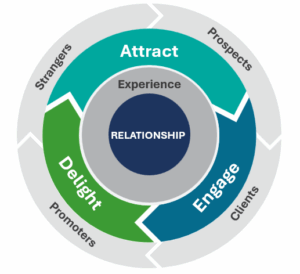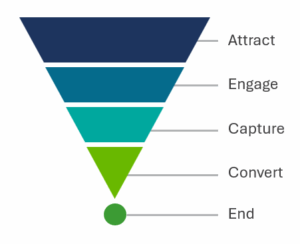We’ve been talking a lot about the Marketing Flywheel lately—the idea that growth isn’t a one-time push but an ongoing cycle of attracting, engaging, and delighting clients. Unlike the old sales and marketing funnel mindset that ends at “conversion,” the flywheel shows that momentum builds when you keep delivering value. This modern approach feels more strategic, because it is. The funnel can still come into play though, just in a more tactical way.
Modern Marketing Flywheel Old Marketing Funnel


So where does a social media funnel fit in?
Think of it as a focused way to add energy to your flywheel. Each funnel campaign is like one strong push that gets new prospects into your orbit. When you follow through with engagement and great client experiences, those same prospects can become promoters who help keep the wheel spinning.
Here’s how you can run a simple 30-day social media funnel.
Step 1: Define Your Goal: Brand awareness, new leads, or appointments booked?
Every campaign should have one clear objective. For example: Book 1-on-1 retirement planning consultations with pre-retirees (ages 50–65).
That single action becomes the point where your funnel supports your larger flywheel of long-term client engagement and referrals.
Pro Tip: Keep it simple: one funnel = one clear conversion point (e.g., book a consultation, download a guide, register for a seminar).
Step 2: Which Social Platform to use?
It’s easy, go where your audience for this campaign is.
- LinkedIn → Best for professionals, retirees, business owners.
- Facebook/Instagram → Strong for community presence, lifestyle storytelling.
- YouTube/Podcasts → Thought leadership and trust building at scale.
Step 3: Create a Lead Magnet
A funnel works best when you give prospects something of real value in exchange for their contact information. To illustrate it, let’s use “The Retirement Risk Checklist” as an example.
I’m sure you’ve come across dozens of versions of retirement risk checklists throughout your career. That’s the point—it’s familiar, easy to digest, and highly relevant to the concerns of pre-retirees. The key isn’t inventing something brand new, but presenting it in a way that reflects your voice and gives prospects a reason to raise their hand and say, “Yes, I want that.”
- This type of resource is short, practical, and useful—perfect for drawing someone into your funnel while also providing you with a new contact to add into your marketing system for ongoing engagement.
- Shared through social media, it drives prospects into your funnel while adding new contacts to your flywheel.
Step 4: Build Your Assets and Map Out a 30-Day Content Plan
For this step, you’ll work on gathering, and maybe even creating digital assets you can use throughout your campaign that tie to your goal you defined in step 1.
You’ll need:
- Landing Page: This is where your leads will go to fill out some basic information in order to obtain your lead magnet. Keep it simple, clean, and with only one call-to-action.
- Social Media Posts: Go for a variety! Short, engaging posts that speak to client pain points. Use video clips, infographics, or carousel posts.
- Email Nurture Sequence: 3–5 emails that provide more education + a call to action.
Week 1 – Awareness
- Video: “The #1 risk retirees face (it’s not what you think).”
- Infographic: “5 ways inflation impacts retirement.”
- Story post: Share a client-friendly scenario about an overlooked retirement risk.
Week 2 – Lead Magnet Push
- Carousel: “7 questions to ask before retiring” → Download the full checklist.
- Video: “The one-page checklist to avoid running out of money.”
- Poll: “Which retirement risk worries you most?”
Week 3 – Authority Building
- Post: Explain one risk in detail with a chart.
- Case study: How you helped a couple prepare for inflation.
- Webinar invite: “3 steps to make your money last.”
Week 4 – Conversion
- Direct CTA: “If you’re 5–10 years from retirement, now’s the time to stress-test your plan. Book a consultation.”
- Story: Share how you’ve helped others prepare.
- Reel: “Don’t wait until retirement to find out if you’re ready.”
Step 5: Nurture Through Email
Once someone downloads your checklist, don’t just send them the PDF and stop there—this is where your marketing platform comes into play.
Pro Tip: Lean Into Your Marketing Platform
Instead of managing new contacts manually, add them directly into your marketing system. FMG, Broadridge and Snappy Kraken are all approved platforms for ESI reps. This lets you:
- Send the checklist as a welcome email.
- Add them to your audience for ongoing newsletters and educational campaigns.
- Trigger nurture sequences that run on autopilot—so while you’re focused on client meetings, your marketing system is building trust in the background.
Example Nurture Flow
- Immediate: Deliver the checklist + quick intro.
- Day 2: Expand on one retirement risk (e.g., inflation).
- Day 4: Share “3 common retirement planning mistakes.”
- Day 7: Invite to a webinar or consultation.
- Day 10: Personal reminder to take action.
With the marketing system doing the heavy lifting, you’re not only following up consistently—you’re also growing a list you can continue to engage with overtime. That means your funnel is no longer a one-off campaign; it’s a steady push that keeps your flywheel spinning.
These marketing systems allow you to develop your own content and get AGT approval seamlessly.
Step 6: Amplify with Ads
Boost posts that promote your lead magnet ($10–$20/day), and use retargeting ads to encourage consultations. These small investments can add significant energy to your flywheel by accelerating reach and conversion.
Note that Facebook/Instagram ads are not approved for use currently. LinkedIn ads, I believe, are approved if comments are turned off. However, there are other types of digital ads that are approved.
A Couple of Housekeeping Notes:
Test + Optimize – It’s so easy to fall short here but you won’t know what’s working – aka what to do more of – if you don’t track it.
- Track: clicks, cost per lead, conversions.
- A/B test your hooks (“Stop running out of money in retirement” vs. “Make your savings last 30+ years”).
- Start small with ad spend, scale what works.
Stay Compliant
- FINRA/SEC rules apply → pre-approve content, avoid testimonials/promissory language, everything needs to be approved by AGT.
- Use approved platforms/tools only
The Bottom Line
Funnels are not the end game—they’re tools. When you use them well, they feed into your flywheel of growth, where the real momentum happens:
- Attract new prospects with content and lead magnets.
- Engage them through email and education.
- Delight them with guidance and planning that builds trust.
And with every delighted client, your flywheel spins faster.
Start with one campaign. One lead magnet. One 30-day funnel. Over time, each spin you create will keep your flywheel moving—and your practice growing.

